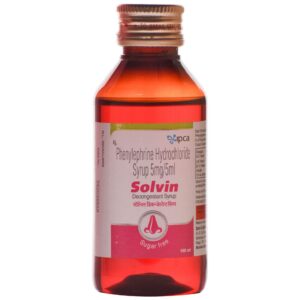BROMHEXINE + PHENYLEPHRINE
Bromhexine: Bromhexine is a medication used to treat respiratory conditions such as bronchitis, chronic obstructive pulmonary disease (COPD), and other conditions that involve excessive production of mucus in the respiratory tract.
The primary mechanism of action of Bromhexine is to promote the clearance of mucus from the respiratory tract. It achieves this by increasing the production of thinner mucus, stimulating the movement of cilia (tiny hair-like structures) that help in the movement of mucus, and reducing the viscosity of mucus. These actions ultimately make it easier for the mucus to be expelled through coughing.
Bromhexine is most commonly available in oral tablet or syrup form. The usual recommended dose for adults is 8-16 mg three times daily, while for children, the dose may vary depending on their age and weight.
Like any medication, Bromhexine may cause side effects, although not everyone experiences them. Some common side effects include abdominal pain or discomfort, diarrhea, nausea, vomiting, headache, and skin rashes. These side effects are usually mild and transient.
It is essential to note that Bromhexine should not be used concurrently with other medications that suppress the cough reflex, such as codeine or dextromethorphan, as it may impair the clearance of mucus and hinder its efficacy. Additionally, Bromhexine may interact with certain medications, so it is important to consult a healthcare professional or read the product label for any potential drug interactions before using it.
Phenylephrine: Phenylephrine is a medication commonly used for nasal congestion, as well as for the management of low blood pressure, dilation of pupils during eye examinations, and as a decongestant in some cold and flu medications.
Its mechanism of action involves constricting the blood vessels in the nasal passages and reducing the swelling in the nasal tissues. This helps to alleviate nasal congestion and improve breathing. Additionally, Phenylephrine is an alpha-1 adrenergic receptor agonist, which means it binds to and activates these receptors in the nasal passages and blood vessels, leading to vasoconstriction.
Phenylephrine is available in various forms, including nasal sprays, eye drops, tablets, and injections. The recommended dose and formulation depend on the intended use and the specific product. It is important to follow the instructions provided by the healthcare professional or the package labeling.
Common side effects of Phenylephrine include headache, dizziness, nervousness, increased blood pressure, trouble sleeping, and a fast or irregular heartbeat. It is essential to consult a healthcare provider before using Phenylephrine, especially in individuals with heart problems, high blood pressure, or thyroid disorders. Phenylephrine may interact with other medications, so it’s crucial to inform the healthcare professional about all the drugs being taken.
It is important to note that Phenylephrine is for short-term use and should not be used for more than a few days without consulting a healthcare professional. Prolonged or excessive use can lead to rebound congestion and worsen symptoms.

